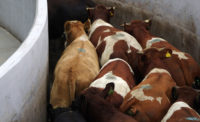Summary
In 2022, there were 71 humane handling enforcement actions posted to the USDA FSIS website. Of those, the majority were related to cattle (46.5%, 33 of 71), followed by swine (36.6%, 26 of 71), sheep (11.3%, 8 of 71) and goats (4.2%, 3 of 71). There was one enforcement action that did not clearly identify the species of animal (1.4%).
Regulatory choices
The Humane Slaughter Act of 1978 (7 USC 1901) and the regulations that enforce it (9 CFR 313) outline the requirements for the humane handling and stunning of red-meat species at slaughter establishments in the United States. The regulations in 9 CFR 313 can be divided into three main categories: stunning, handling and facilities. In 2022, 71.8% (51 of 71) enforcement actions were stunning related, 4.2% (3 of 71) were handling related, and there were no facility-related enforcement actions. In addition to these, 23.9% (17 of 71) of enforcement actions in 2022 were classified as “multiple.” Multiple was defined as two distinct reasons that caused the enforcement action, for example, stunning and handling. Multiple also included any events where an establishment employee cut the throat of a sensible animal, with the exception of ritual slaughter.
There are two primary actions that FSIS may take following an alleged violation of 9 CFR 313: notice of suspension (suspension) or notice of intended enforcement (NOIE). Suspension discontinues inspection services until the humane handling issues are appropriately addressed. Inspection may resume following a response that has been reviewed and approved by the corresponding district office. A NOIE is a warning which provides notification to an establishment that there is basis for FSIS to suspend inspection. However, a NOIE provides the opportunity for an establishment to take immediate corrective action and resume production under inspection. If appropriate action is not taken within three business days, a NOIE can turn into a suspension. In 2022, 76.1% (54 of 71) of enforcement actions were suspensions and 9.9% (7 of 71) were NOIEs. A reinstatement of suspension occurs following a suspension when follow-up action is not sufficient to address humane handling concerns and another event occurs — 14.1% (10 of 71) of enforcement actions in 2022 were reinstatement of suspensions.
There are two possible follow-up actions following an enforcement action: abeyance or deferral. An abeyance can be issued following a suspension or reinstatement of suspension — stated as suspension held in abeyance or reinstatement of suspension held in abeyance. An abeyance indicates that the enforcement action has been lifted, the establishment may operate under the mutually agreed-upon conditions, and that inspection may resume. In 2022, abeyances were issued following all suspensions (54 of 54) and reinstatements of suspension (10 of 10). A deferral can be issued following a NOIE — a letter of deferral indicates that an establishment has proposed adequate corrective and preventative actions. In 2022, deferrals were issued following all (7 of 7) NOIEs.
Handling
In 2022 there were three of 71 (4.2%) enforcement actions that solely involved the handling of cattle or pigs. The handling-related enforcement action category in this project included improper handling events and improper treatment of nonambulatory animals. The one enforcement action related to pigs in the handling category described an incident where a large boar was punched in the neck and face by a handler. The remaining two enforcement actions occurred with cattle. One involved a potential compound fracture of a tail that may have occurred during handling very shortly before restraint. The second cattle-related incident occurred during the unloading of a double-decked semi-trailer. The lower level of the trailer was overcrowded, the animals appeared heat-stressed, and the establishment did not take action to unload until prompted by FSIS personnel. The ambient temperature was above 90 degrees Fahrenheit. At the time of unloading, several nonambulatory cattle were discovered. Some of those cattle were trampled by cattle that could walk. Overall, 19 cattle were unloaded, and 11 were euthanized. Each of these events could have been avoided with situational training for animal handlers and proactive management. In the case that involved cattle on an overcrowded trailer, it is important for the establishment to provide clear feedback regarding the difficult situation that they faced to the transport company and the site of origin for the cattle on board. The decisions that were made by the people who loaded the trailer contributed to the event that occurred.
Stunning
In 2022, the majority (71.8%, 51 of 71) of enforcement actions were related to stunning. Of these, the most involved mechanical stunning (88.2%, 45 of 51) — captive bolt and gunshot. Electrical stunning comprised 7.8% (4 of 51) of stunning-related enforcement actions, and 3.9% (2 of 51) of stunning-related enforcement actions did not clearly state the type of stunning. Ritual slaughter was not involved in any enforcement actions that were classified as stunning related for 2022. The majority (41.2%, 21 of 51) of stunning-related enforcement actions involved events where an animal was stunned a total of three times before they were rendered insensible or maintained insensibility. Four stuns were needed for animals to be rendered insensible in 27.5% (14 of 51) of enforcement actions, and for 23.5% (12 of 51) of enforcement actions, two stuns were required for animals to be rendered insensible. Five stuns were required for an animal to be rendered insensible in 2.0% (1 of 51), and seven stuns were required for an animal to be rendered insensible in 2.0% (1 of 51) of enforcement actions. There were 2 (3.9%) stunning-related enforcement actions that did not clearly state how any stuns were required for an animal to be rendered insensible and maintain insensibility.
The reason for stun failure was not clearly described for the majority (62.7%, 32 of 51) of stunning-related enforcement actions. Of the enforcement actions where a reason for stun failure was clearly described, 27.5% (14 of 51) involved issues with placement and 9.8% (5 of 51) involved issues with restraint. There were no stunning-related enforcement actions due to equipment issues or excessive time between stunning and exsanguination in 2022.
Of the 45 enforcement actions involving mechanical stunning, 67.4% (29 of 43) of the first stuns were made with a captive bolt, 30.2% (13 of 43) of the first stuns were made via gunshot, and 2.3% (1 of 43) of enforcement actions did not clearly describe the type of mechanical stunning that was first used.
Multiple issues
In 2022, there were 17 enforcement actions that were classified as “multiple.” Of these enforcement actions, most (82.4%, 14 of 17) involved both stunning and handling issues, followed by handling and facility issues (11.8%, 2 of 17), and stunning and facility issues (5.9%, 1 of 17). The “multiple” category includes enforcement actions where more than one of the three reasons (stunning, handling and facilities) contributed to the causative event. The corrective actions for these events often include a combination of physical fixes and changes coupled with training of handlers and stunner operators.
Where to start: focus on training
Of all enforcement actions issued in 2022, the majority (56 of 71) involved stunning. Of these 56 enforcement actions that involved stunning, 51 were classified as stunning-related and 15 were classified as “multiple” where stunning was one of the causative factors. The number of stuns it took to effectively stun animals involved in these enforcement actions ranged from one to seven. Fortunately, there are ways to improve stunning outcomes: using equipment that is appropriate for the type of animal, employing proper restraint methods and ensuring proper stun placement.
Training is very important in preventing events that could result in enforcement actions. In nearly all cases, the decisions that were made by handlers and stunner operators determined the outcome of the situation. Although it is impossible to train to all prospective events, workers can be provided with options to consider as they approach new situations. A critical first step is to encourage them to think as challenging situations unfold. The pressure of keeping up workflow can cloud decision making. Hearing managers say that it is important to pause and think before proceeding can make the difference between a well-handled challenge and one that leads to a humane handling enforcement action. This difference can be made through more deliberate and well-thought-out choices by handlers and stunner operators.
Stunner operator training should be approached in a stepwise manner and monitored by a successful and well-practiced stunner operator. The trainee should first receive instruction regarding stunning procedures and then observe, but should not be allowed to stun live animals. The trainee should then progress to practicing stuns on the heads of dead animals that have been stunned. These heads can be skinned or unskinned, but it is important that they are split lengthwise with a band saw or head splitter following the practice stun — this allows the trainee to visualize both the bolt path and the location of the brain. Once trainees have progressed through the first two steps and are ready to begin stunning live animals, they should only be allowed to operate the stunner for short periods of time — this is important for allowing the stunner operators' bodies to adjust to the physical demands of the job. Stunner operators have a mentally draining job, so it is critical to check on their mental well-being regularly. Good management can identify physical or mental fatigue and intervene before a crisis occurs.
The best way to prevent humane handling enforcement actions is to prevent egregious incidents from occurring. It is important for establishments to have a robust systematic approach to animal welfare that utilizes a HACCP-like approach of monitoring, tracking and responding to humane handling risks. A focus on ‘doing the right things’ helps to set a culture that gets the most out of robust humane handling programs.





Report Abusive Comment